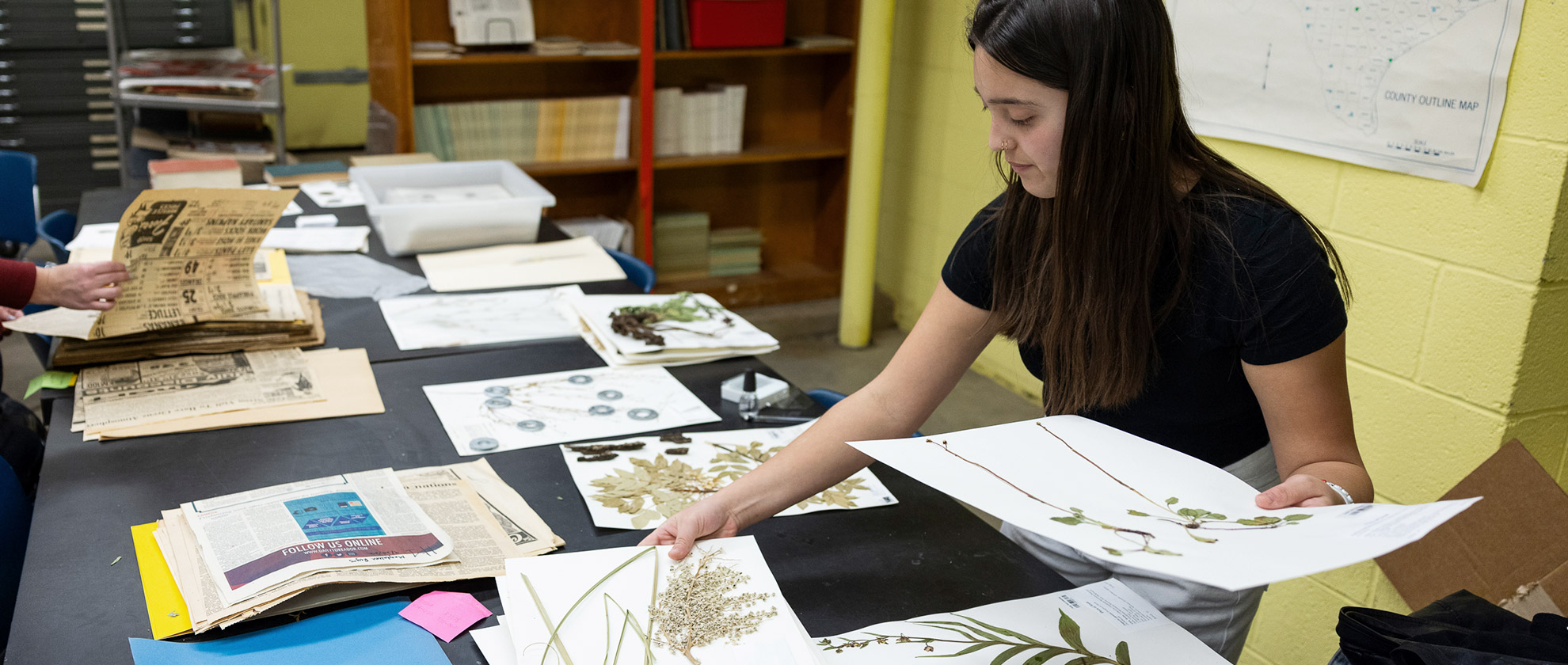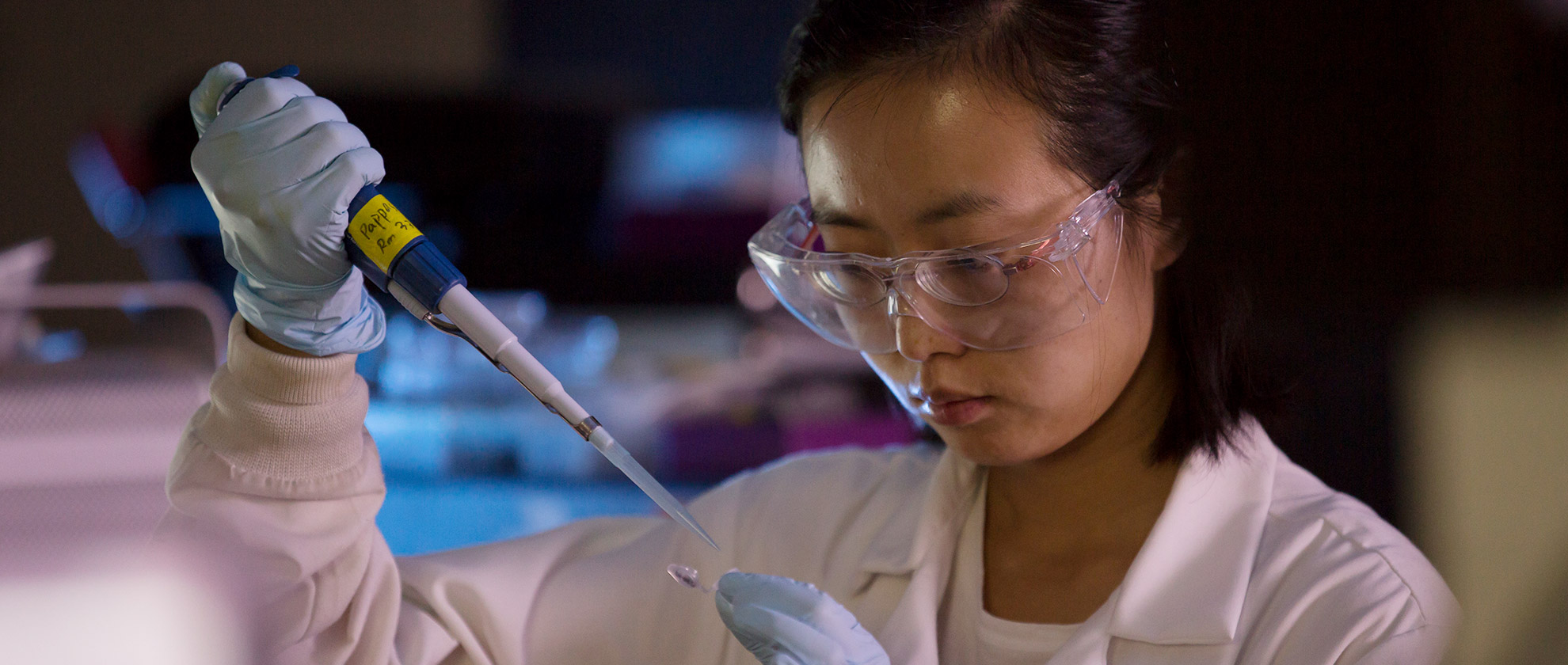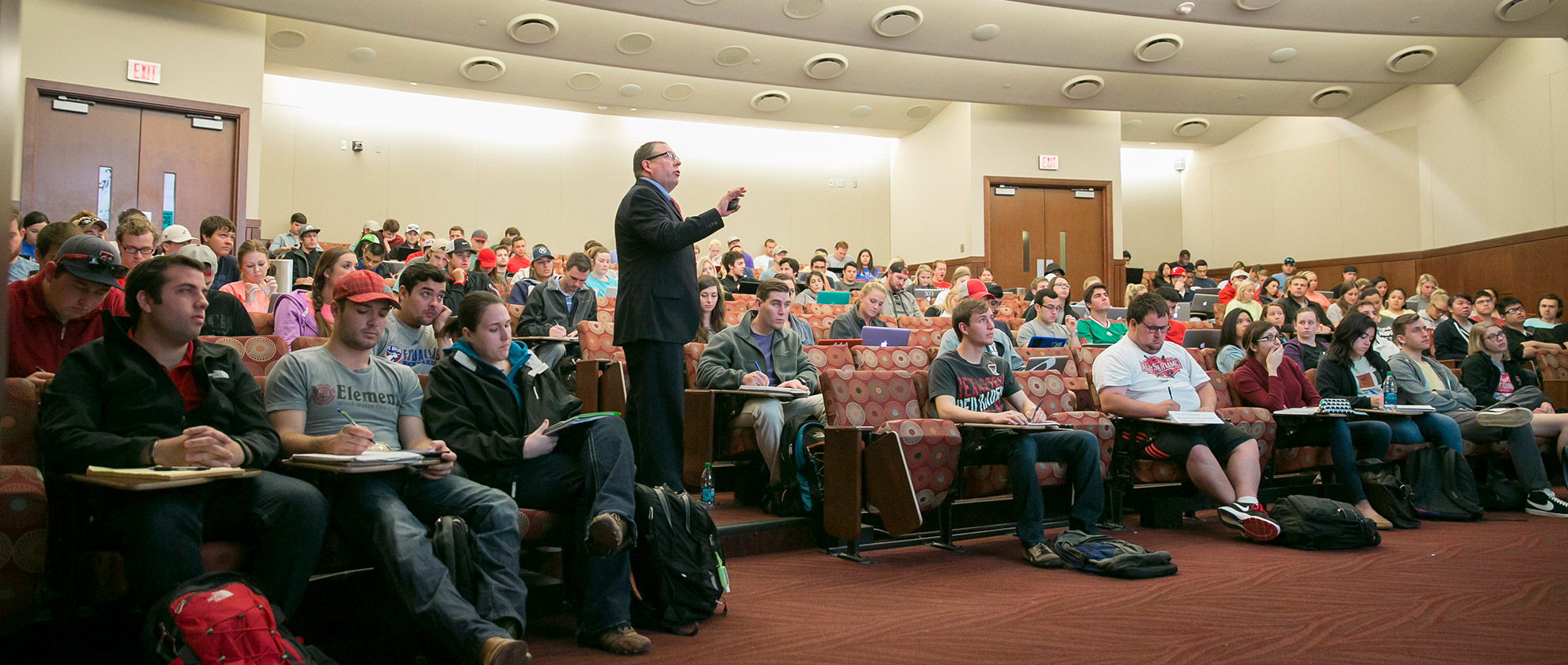Strategic Priority 2
Develop, Catalyze and Promote Innovative Research & Creative Activities
- Enhance and amplify the impact, visibility and real-world application of research and creative activities
- Strengthen and cultivate the capacity for facilities and instrumentation that support research activities
- Promote and expand an integrated learning culture that supports and empowers internal and external interdisciplinary collaboration
- Focus on tenure-track and tenured faculty hires in support of AAU eligibility in research areas of strength

Goal 1: Enhance and amplify the impact, visibility and real-world application of research and creative activities.
We will...
- Enhance the national and global visibility of research by increasing scholarly output and strengthening knowledge dissemination across a variety of platforms including Texas University Fund (TUF) funding opportunities.
- Remove barriers and strengthen interdisciplinary solutions by fostering meaningful and complementary collaborations among researchers from different disciplines, amplifying creativity and values.
- Develop actionable policies that drive meaningful change and strengthen community advocacy. Strengthen entrepreneurial activity to bridge research, commercialization and industry collaboration, driving innovation and world impact.
- Train and facilitate researchers and students on pathways to commercialization, industry partnerships, intellectual property rights and discipline-specific entrepreneurial strategies.
- Strengthen engaged scholarship by fostering meaningful, reciprocal relationships between researchers and communities, ensuring shared value of engaged scholarship to both communities and academic evaluators.
- Facilitate pathways to membership in the Association of American Universities (AAU) related to research culture and infrastructure.
Key Performance Indicators
By 2030, we aspire to:
- Increase the number of high-quality, high-citation publications and scholarly works, books and book chapters, performances and citation indices (71,548 10-year average citations).
- Increase the number of inventions, patents, start-ups and commercialized products.
- Expand contributions to high-impact, high-visibility media and public-facing works and activities (e.g., podcast hosting and appearances, media interviews, journal/newsletter stories, workshops, exhibits and activities).
- Increase the number of external exhibits, performances, presentations with high impact on higher education, communities, industry-led enterprises, as well as increased presentations and attendance at national and international conferences.
- Enhance visibility measured by numbers of prestigious lectures, awards and leadership roles in professional organizations and elected members in national academies.
Highlighted Initiatives
Edward E. Whitacre Jr. College of Engineering Research Day
The Edward E. Whitacre Jr. College of Engineering Research Day brings together students, faculty and industry professionals to explore cutting-edge advancements in biomedical engineering, cybersecurity, data science, robotics, alternative energy and more. It highlights the college's commitment to fostering innovation, collaboration and the pursuit of knowledge in various engineering disciplines.
University Libraries Article Processing Charges
The University Libraries encourage open access article publishing by providing financial support for Article Processing Charges via their agreements with high-impact publishers, allowing for wider distribution and influence of Texas Tech research.
Rawls College of Business Alderson & Griffin Center for Family Business & Entrepreneurship
Rawls College of Business Alderson & Griffin Center for Family Business & Entrepreneurship is a hub for driving entrepreneurial innovation, supporting family businesses and fostering community engagement with cutting-edge tools and actionable insights. Positioned at the intersection of corporate enterprise, startup innovation and academic excellence, the Center is dedicated to championing bold ideas and collaborative efforts that push the boundaries of modern business creation and entrepreneurial ecosystems.

Goal 2: Strengthen and cultivate the capacity for facilities and instrumentation that support research activities.
We will...
- Develop a robust infrastructure of enhanced resources for grant management, both pre- and post-award support.
- Foster partnerships with industry, national laboratories and peer institutions to access specialized expertise, equipment and facilities.
- Reward and value research accomplishments of faculty, students and staff by recognizing achievements, offering financial incentives and paving a clear career pathway for advancement.
- Align promotion and tenure policies with research engagement, innovation and impact and offer structured pathways for faculty advancement in research administration and institutional leadership roles.
- Support researchers through cultivating an environment that encourages high-risk, high-potential and high-reward research.
Key Performance Indicators
By 2030, we aspire to:
- Increase measures of stability and resilience in research and creative activities in comparison to our cohort of comparable universities, such as faculty attrition, federal awards and high-quality, high-impact publications with time as related to external pressures and funding landscapes.
- Increase research expenditures (restricted, federal, non-federal) and increase collaborative center grants (e.g., cross-college and cross-institution) to $396,004,487.
- Increase the number and quality of services, resources and facilities to support research for all stages of career development, including adding new core labs and improving the competitive pricing structure and utilization by faculty and external partners.
- Increase the number, quality and accessibility of field research sites and creative performance or exhibit venues external to campus.
- Improve faculty and staff retention, promotion and tenure/continuation of appointment success across employment types and career stages. Sustain 95% or greater retention rate for assistant and associate professors.
Highlighted Initiatives
Faculty Awards
A suite of faculty awards designed to recognize outstanding contributions in teaching, research, creative activity, and engagement across all appointment types launched in September 2025. These designations reflect Texas Tech's commitment to faculty success and help support broader strategic priorities, including its pursuit of AAU membership.
These awards complement existing honors such as the Horn Professorship, expanding our recognition framework to celebrate excellence at every stage of a faculty member’s career.
Fiber and Biopolymer Research Institute
The Fiber and Biopolymer Research Institute (FBRI) at Texas Tech serves university researchers, cotton breeders, public agencies, and textile manufacturers, supporting innovative research that is redefining how fiber quality is understood around the world. In just 10 minutes, Texas Tech researchers can convert low-quality cotton fibers into a cellulose gel, which can then be molded into bioplastics.

Goal 3: Promote and expand an integrated learning culture that supports and empowers internal and external interdisciplinary collaboration.
We will...
- Facilitate dialogue among faculty, students and staff to uncover barriers to forming interdisciplinary teams.
- Assess the full cycle of interdisciplinary projects and identify the specific resources needed at key points toward fulfillment or sustainability.
- Catalyze opportunities to form collaborations in meaningful ways, including international collaborations and external partnerships with institutions and industry.
- Demonstrate commitment to unique and original ideas through salon-style think tank forums, including collaborative formats with the Texas Tech Innovation Hub.
- Advance the scholarship of teaching by fostering research in pedagogy to enhance teaching quality, innovation and future-oriented methodologies.
Key Performance Indicators
By 2030, we aspire to:
- Increase the number and quality of long-term, interdisciplinary research and creative endeavors.
- Increase participation in Study Abroad and student exchange programs.
- Increase international and domestic collaborations with institutions, industries and communities outside of Texas Tech.
- Increase the number of multidisciplinary and multicareer stage teams, including faculty, staff, students and community partners.
- Increase the number and quality of tangible investments in, and outcomes of, engaged scholarship.
Highlighted Initiatives
The Critical Infrastructure Security Institute
The Critical Infrastructure Security Institute (CISI) brings together research in a variety of disciplines to find solutions that decrease the vulnerabilities of the electric grid, water utilities and other infrastructures that are critical to our region, state and nation’s economies. CISI researchers are developing a framework that focuses on rural utilities in the Texas power grid to address various stages of cyber-physical attacks, including attack detection, prevention, and impact analysis and recovery plans.
Vernacular Music Center
The mission of the Vernacular Music Center (founded in 2000) is to provide a center for in-depth interdisciplinary research, study, teaching and advocacy on behalf of the world's vernacular musics and dance—their construction, history and role in defining cultural life in human communities—in all cultures and historical periods, and the contributions they can make in the modern world. It is the first research center housed within the Talkington College of Visual & Performing Arts to be officially recognized by the Office of the Vice President for Research and Innovation. The VMC is an innovator in building partnerships and generating outside funding for these initiatives, with grants from the Fulbright Foundation, the National Endowment for the Arts and Civic Lubbock.

Goal 4: Focus on tenure-track and tenured faculty hires in support of AAU eligibility in research areas of strength.
We will...
- At least 60% of faculty hires will support TUF or other strategic research initiatives.
- Ensure that adequate space and facilities are available for all additional hires.
- Align university strategic hiring plans through specific, existing recruitment initiatives.
- Prioritize research areas of strength: Systems Resilience & Adaptability, Powering Our Future; Advancing One Health; Urban & Rural Development; Strengthening National Security.
- Identify onboarding needs and requirements.
- Pursue and leverage faculty hires competitive with funding for the Governor’s University Research Initiative (GURI) and the Cancer Prevention and Research Institute of Texas (CPRIT).
- Catalyze new and expand existing strategic research initiatives.
- Identify the organizational structure for each center and institute with a lead administrative officer.
- Stratify the levels of faculty to determine a balance of early and mid-career faculty.
- Ensure five-year institutional investment of $300M ($200M from TUF) in expanding Texas Tech research endeavor.
Key Performance Indicators
By 2030, we aspire to:
- Significantly increase the number of hires of tenure-track/tenured faculty per year for each of the next five years.
- Recruit high-performing faculty into distinguished professor positions.
- Align faculty hired around strategic priorities with a minimum of 50% research workload activity.
- Identify the number of TUF-funded faculty lines that will be strategic research distinguished professorships including outreach and engaged scholarship.
- Determine the types of onboarding provided for new faculty including relocation, integration, schools and activities (families), and partner employment opportunities.
Highlighted Initiatives
Institute for Genomics for Crop Abiotic Stress Tolerance
Researchers at the Institute for Genomics, Crop Adaptation, and Sustainability in Texas (IGCAST) are advancing studies across the continuum from genome to phenome, applying genomics tools to understand how crops respond to challenging environments while also improving nutritional value and fiber quality. The institute’s work also includes the development of bioengineering approaches for producing food from carbon dioxide—a potential response to global food insecurity, with an estimated 820 million people worldwide undernourished. IGCAST’s focus on these complex challenges is helping to attract faculty with expertise in plant science, genomics and sustainable food systems.
Center for Advancing Sustainable & Distributed Fertilizer Production
The Center for Advancing Sustainable & Distributed Fertilizer Production (CASFER) is developing new systems to recover and reuse nutrients from waste streams such as livestock operations, wastewater treatment plants and agricultural runoff. Their research addresses a critical challenge: nearly half of the world’s food supply relies on fertilizers produced through the energy-intensive Haber-Bosch process, and a significant portion of these fertilizers are lost to the environment before reaching crops. By creating technologies that enable more efficient nutrient recovery and reuse, CASFER is contributing to a more resilient food system and attracting researchers interested in advancing sustainable agriculture and environmental protection.
Institute for One Health Innovation
Institute for One Health Innovation (IOHI) trains scientists and health professionals in leading transdisciplinary research and developing innovative solutions for today’s most pressing One Health problems. IOHI brings together researchers and practitioners from Veterinary Medicine, Texas Tech Health Sciences Center and the College of Health & Human Sciences to tackle cancer, addiction studies, pain therapy, aging-related diseases, autoimmune disorders, genetics, drug interactions, speech therapy, medical devices.
Strategic Plan
-
Address
Texas Tech University, 2500 Broadway, Lubbock, TX 79409 -
Phone
806-742-2011 -
Email
provost.communications@ttu.edu
